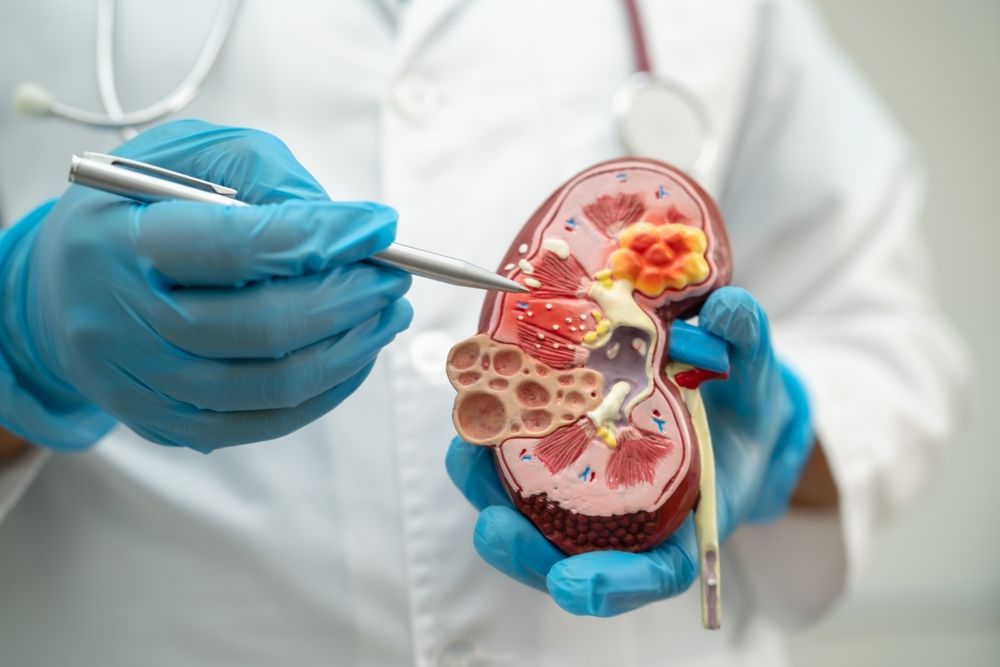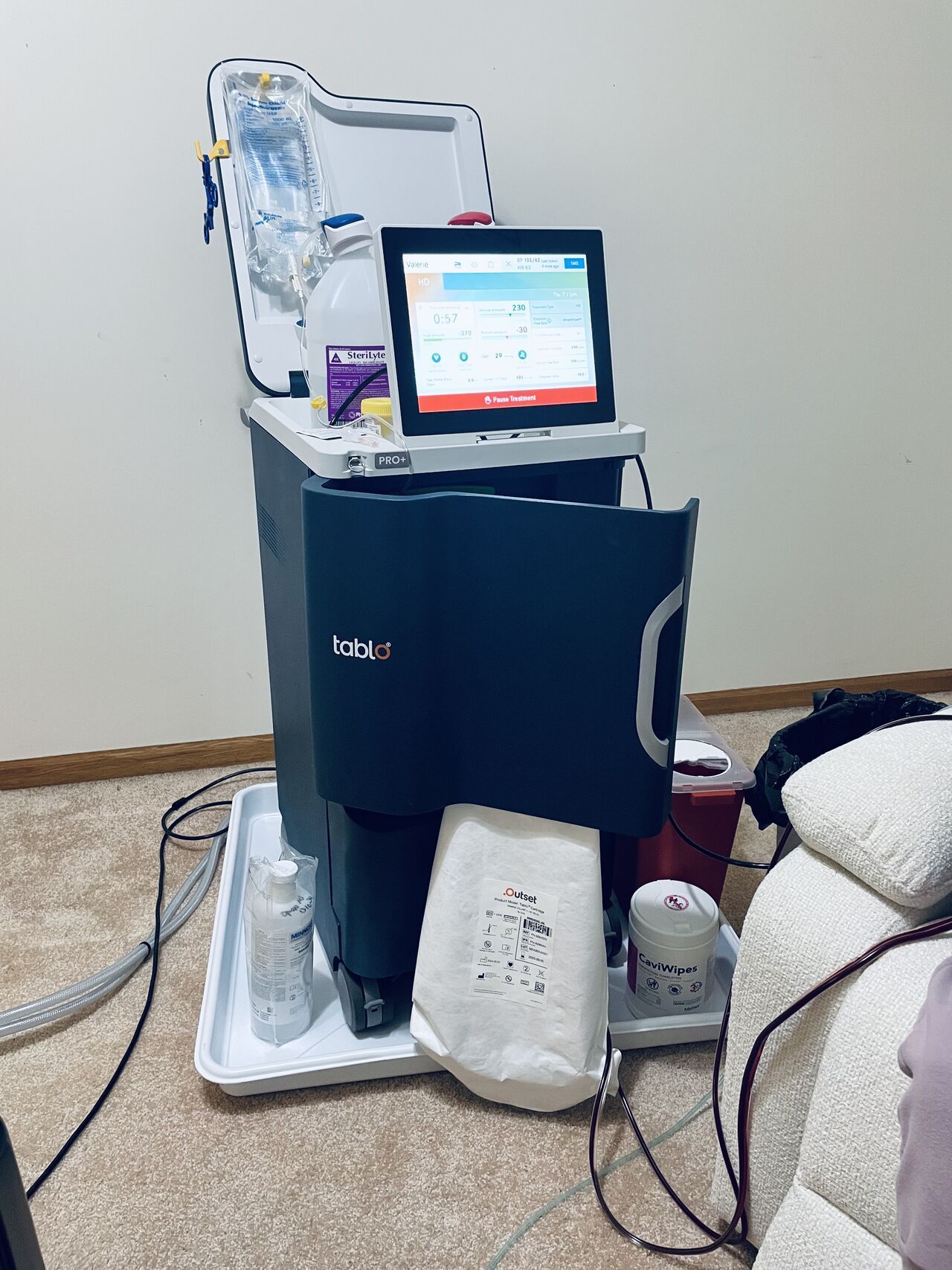Peritoneal Dialysis Treatment Coming Soon!
Written by: Vitality Dialysis

Chronic Kidney Disease (CKD) is a long-lasting condition that goes through five stages of kidney function loss. With CKD, the kidneys struggle to keep up with the demands of filtering waste products out of the bloodstream. Elevated levels of excess fluid and toxins gradually build up in your system as a result. Unfortunately, clear signs of kidney disease often don’t manifest until the later stages of the disease. Kidney health is critical for overall health. Educate yourself about the stages of chronic kidney disease, its symptoms, and treatment options.
What is Chronic Kidney Disease (CKD)?
Chronic kidney disease means that the kidneys are damaged and can’t function at their optimal levels. As we age, kidney function naturally declines somewhat, but other chronic diseases and lifestyle factors can accelerate this decline. High blood pressure, diabetes, a high-salt, high-sugar, highly processed diet, and chronic dehydration are key risk factors that harm the kidneys.
Kidney function is essential to life itself. The kidneys clean your blood supply, removing toxins, waste products, and excess fluids, which get sent out of your system through urination. As kidney function declines in CKD, it’s harder for the kidneys to filter your blood, so waste products and excess fluids build up in your body. Without treatment, the late stages of kidney disease and kidney failure can be deadly. Treatment during earlier stages of chronic kidney disease involves making lifestyle changes and slowing down kidney damage. People experiencing these stages of CKD require dialysis or a kidney transplant to live.
Stages of Chronic Kidney Disease
Chronic kidney disease has five stages ranging from mild to kidney failure. Although there is no cure for CKD, catching and monitoring the disease in its earlier stages can prolong kidney function and delay more severe stages that come with more complications and a higher risk of death. The most noticeable symptoms of CKD typically only happen in the later stages, but understanding the stages of chronic kidney disease can help patients and their healthcare providers prolong life and delay complications for as long as possible.
Healthcare providers can determine the stages of CKD based on lab tests and a math formula called the “glomerular filtration rate” (GFR). The GFR’s variables include a patient’s gender, height, weight, ethnicity, age, and a blood test measuring the level of the waste product creatinine in the blood.
Healthy kidneys can remove creatinine from the blood, so low levels signal healthy kidney function. Higher levels indicate progressing loss of kidney function and potentially CKD.
Early Stages of CKD
Early stages of chronic kidney disease using the GFR are listed below:
- Stage 1: 90 and higher—The kidneys are working well but may have mild signs of damage.
- Stage 2: 60 to 89—Although the kidneys are still working well, additional signs of mild damage are present.
- Stage 3a: 45 to 59—Kidney function is declining perceptibly into the moderate range. You may notice some mild symptoms.
- Stage 3b: 30 to 44—Kidneys display moderate damage and are not working efficiently. If treatment begins now, people can slow or halt the progression of the disease at this point.
We cover the details of each of these early stages of chronic kidney disease below:
Stage 1: Mild Kidney Damage with Normal Function
At this early stage, there is some mild damage to the kidneys, but they can still adapt and function very well, at about 90% capacity or more. There are often no symptoms associated with this stage of CKD, but blood tests may show elevated creatine levels while urine tests may show elevated albumin protein levels. Patients undergoing care for diabetes or high blood pressure are often tested for these levels because those are major risk factors for CKD. At this stage, keeping these related conditions under control and using lifestyle modifications can slow or stop kidney damage from progressing. For example, focusing on a healthy diet with sodium levels under 2,300 mg daily, and lower blood sugar levels are important strategies.
Stage 2: Mild Kidney Damage with Reduced Function
At stage 2, kidneys display between 60% and 89% function based on the GFR. Kidney damage has progressed but is still mild enough that easy-to-diagnose symptoms are not showing yet. However, non-specific symptoms such as high blood pressure, frequent urinary tract infections, blood in the urine, foamy urine, or swelling in the hands and feet may indicate signs of kidney decline. Again, lifestyle changes like lowering stress levels, improving nutrition, exercising, getting plenty of sleep, and managing risk factors like diabetes and high blood pressure can stall kidney damage at this stage.
Stage 3: Moderate Kidney Damage
Most patients are diagnosed with chronic kidney disease somewhere between stages 3a and 3b of CKD.
- Stage 3a chronic kidney disease shows the kidneys functioning between 45% and 59% capacity.
- Stage 3b CKD kidney function measures between 30% and 44% of normal capacity.
At stage 3, the kidneys struggle to remove waste products, excess fluids, and toxins from the bloodstream, and symptoms become more obvious, and a blood test will confirm the creatine buildup. Although symptoms can vary between patients at this stage, some of the common symptoms include:
- Changes in urination (more or less than usual, blood in the urine, foaminess)
- Fatigue
- Back pain
- Changes in appetite
- Problems sleeping
- Swelling in the feet and hands
- Itchy skin
- Muscle cramps
- Numbness and tingling in the extremities
Additional complications may include anemia, high blood pressure, and bone loss.
Late Stages of CKD
The late stages of chronic kidney disease go from very poor function all the way to complete kidney failure, which patients can only survive through
dialysis or kidney transplant. By this time, symptoms are more obvious and distressing.

Stage 4: Severe Kidney Damage
At stage 4, kidney function has fallen between 15% and 29% of normal capacity. Kidney damage is severe and kidney failure is close. At this point, your healthcare provider will help you try to prevent progression to kidney failure and may recommend preparing for dialysis regularly. Toxins and extra fluids are building up in your blood, causing systemic damage to other organs and body parts, which leads to symptoms that may include a worsening of symptoms previously mentioned, but also :
- Chest pain
- Inability to concentrate
- Nausea and vomiting
- Shortness of breath
- Swelling of extremities
- Severe fatigue
- Anemia
- Bone loss
- Higher blood pressure
At this stage, your risk of cardiovascular problems and stroke increases as well. It’s critical to work with your doctor to slow or prevent further damage and to discuss the need for dialysis or kidney transplants if your CKD worsens to the failure stage.
Stage 5: Kidney Failure (End-Stage Renal Disease)
By stage 5, the kidneys are damaged down to 15% capacity or lower. The kidneys are about to fail or already have. Dialysis or a kidney transplant are the only ways to ensure that your blood is cleaned and filtered so you can survive. All the symptoms listed above will be more obvious and life-threatening. Immediate care is needed to sustain life.
Causes & Risk Factors of CKD
Chronic kidney disease can happen to anyone, but some people run an elevated risk of CKD because of other conditions they may have, including:
- Heart disease
- High blood pressure
- Diabetes
- Kidney disease in your family history
- You are over the age of 60
- You have had to rely on NSAID pain-relief drugs for a long time
Possible Complications of Chronic Kidney Disease
Whether or not you have any of the aforementioned risk factors, it’s essential to watch for kidney dysfunction, especially as you age. Poor kidney capacity can cause many other dangerous health complications, including:
- Anemia (low red blood cell count)
- Heart disease
- Weak bones
- Metabolic acidosis (an acid-base blood chemical imbalance)
- Gout
- High blood pressure
- Elevated levels of potassium and/or phosphorus in the blood
- Nerve damage (peripheral neuropathy, often signaled by numbness and tingling in the extremities)
- A weak immune system
- Edema (swelling because of excess fluid buildup) in the hands, ankles, and feet especially.

Treatment Options for CKD
Chronic kidney disease treatments will depend on the stage, symptoms, and risk factors of your diagnosis. Although there is no cure for CKD, it can be managed and stalled in the earlier stages. Work with your doctor on the best treatment options and lifestyle adjustments for your situation so that you can keep your kidneys working at their highest capacity possible, wherever you are at the moment. If, however, you don’t receive a diagnosis until stages 4 or 5, you’ll need to work with your doctor to make decisions about starting dialysis or getting on a kidney transplant list.
At-Home Dialysis Treatments
Dialysis is a life-saving treatment that filters, cleans, and balances electrolytes in the blood in place of the kidneys. Patients progressing through stage 4 to stage 5 should discuss
dialysis treatment options with their doctor and prepare for receiving this treatment if kidney decline cannot be stopped and failure is expected. Today, it is possible to receive at-home dialysis instead of always traveling to a dialysis center or hospital for treatment. Vitality Dialysis provides patients with this option, which gives them more control, convenience, and comfort during treatment, saving them time and improving their quality of life. Patients receive the equipment,
training, and
ongoing monitoring by nurses and technicians to ensure patients have the best outcome and comfort from the experience.
Kidney Transplant
Many kidney failure patients are also eligible to receive kidney transplants. Patients with kidney failure usually have to wait for months to years for an eligible match, however, which means that they need to continue receiving dialysis treatments as they wait.
Lifestyle Changes
No matter what stage of CKD a patient is experiencing, lifestyle changes are necessary. Continue working with your doctor on managing other conditions, risk factors, and symptoms. If CKD is in its early or moderate stages, it is still possible that adjusting your diet, exercise, sleep, and care for diseases like high blood pressure and diabetes can prevent kidney disease from getting worse.
Embrace Independence with Home Dialysis
Nevertheless, even patients with late-stage CKD or kidney failure can live full, engaging lives with an improved quality of life on home dialysis. Receiving dialysis at home improves outcomes and comfort levels, saving patients hours of travel time and enabling them to continue work, school, and family activities, even as they receive home dialysis.
Contact Vitality Dialysis today to learn more.
© Copyright 2024 | Vitality Dialysis Privacy Policy |
Website imagined and executed by RivalMind.
Contact






